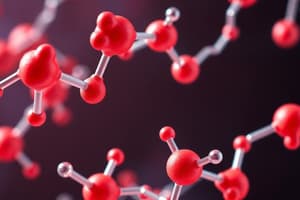Podcast
Questions and Answers
What is bioinformatics?
What is bioinformatics?
Bioinformatics is an interdisciplinary field of science that involves using computer technology to collect, store, analyze, and disseminate biological data and information, such as DNA and amino acid sequences or annotations about those sequences.
How is bioinformatics related to genetics and genomics?
How is bioinformatics related to genetics and genomics?
Bioinformatics, as related to genetics and genomics, is a scientific subdiscipline that involves using computer technology to collect, store, analyze, and disseminate biological data and information, such as DNA and amino acid sequences or annotations about those sequences.
What are some examples of definitions of bioinformatics?
What are some examples of definitions of bioinformatics?
There are many different definitions of bioinformatics, such as: The retrieval and analysis of biochemical and biological data using mathematics and computer science, as in the study of genomes; The collection, classification, storage, and analysis of biochemical and biological information using computers, especially as applied to molecular genetics and genomics.
What does computational molecular microbiology involve?
What does computational molecular microbiology involve?
What is one potential project idea for studying a gene/protein sequence?
What is one potential project idea for studying a gene/protein sequence?
How can in silico analyses be viewed and approached?
How can in silico analyses be viewed and approached?
What are some tools and approaches that can be used to explore a gene or protein?
What are some tools and approaches that can be used to explore a gene or protein?
How can various analyses integrate with each other, and what questions can they address?
How can various analyses integrate with each other, and what questions can they address?
- What is bioinformatics?
- What is bioinformatics?
- What are examples of biological data?
- What are examples of biological data?
- What types of data are found in bioinformatics?
- What types of data are found in bioinformatics?
- What are examples of linear data structures in bioinformatics?
- What are examples of linear data structures in bioinformatics?
- What are examples of non-linear data structures in bioinformatics?
- What are examples of non-linear data structures in bioinformatics?
- What are biological databases and how are they managed?
- What are biological databases and how are they managed?
- What are examples of biological databases?
- What are examples of biological databases?
- What types of bioinformatics tools are available for analyzing biological data?
- What types of bioinformatics tools are available for analyzing biological data?
- What are algorithms in the context of bioinformatics?
- What are algorithms in the context of bioinformatics?
- What are some examples of bioinformatics algorithms?
- What are some examples of bioinformatics algorithms?
- What are Markov chains and Hidden Markov Models (HMM) used for in bioinformatics?
- What are Markov chains and Hidden Markov Models (HMM) used for in bioinformatics?
- How is HMM used in bioinformatics?
- How is HMM used in bioinformatics?
Flashcards are hidden until you start studying
Study Notes
Introduction to Bioinformatics and Bioinformatics Algorithms
- Bioinformatics is an interdisciplinary field that uses biology, chemistry, physics, computer science, programming, mathematics, and statistics to analyze and interpret biological data.
- Biological data includes DNA, RNA, protein sequences, genome coordinates, biological pathways, and gene expression data.
- Types of biological data include characters, strings of characters, integers, floating point numbers, and booleans.
- Data structures can be linear (e.g., linked lists, arrays, stacks) or non-linear (e.g., trees, graphs).
- Databases are organized collections of structured data, commonly managed by a Database Management System (DBMS).
- Biological databases include GenBank, NCBI Protein, UniProt, PDB, NCBI Genome, Ensembl, UCSC, and KEGG.
- Bioinformatics tools can be web-based or desktop-based for analyzing biological data.
- Algorithms are well-defined steps for solving a problem and often involve specific data structures.
- Bioinformatics algorithms include exhaustive search, greedy algorithms, dynamic programming, divide and conquer, and Hidden Markov Model (HMM).
- Markov chains are stochastic processes with the Markov property, while HMM is a more general term for stochastic models with hidden states.
- HMM is used to model sequences, such as genes, and can differentiate between different features within a sequence, like introns and exons.
- HMM uses emission probabilities to assign nucleotides to states and transition probabilities to move between states in a sequence.
Studying That Suits You
Use AI to generate personalized quizzes and flashcards to suit your learning preferences.




